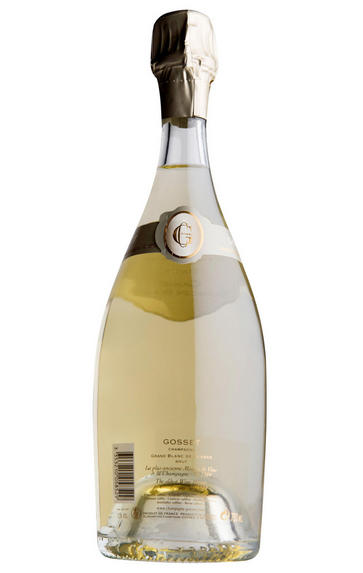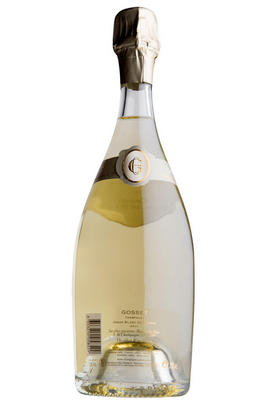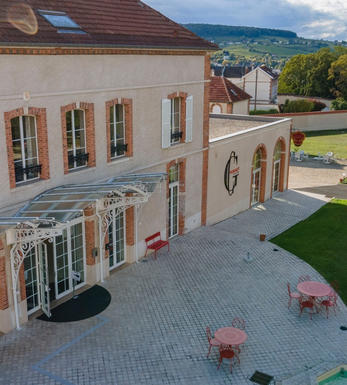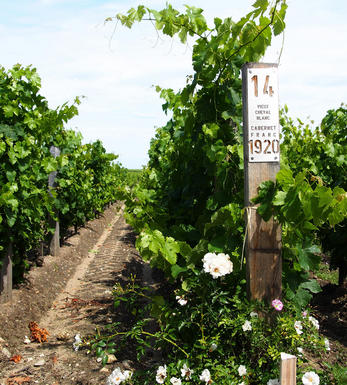
Champagne Gosset, Blanc De Blancs, Brut

Critics reviews
The latest rendition of Gosset's NV Brut Grand Blanc de Blancs reveals youthful aromas of citrus zest, white flowers and almond paste. Medium to full-bodied, bright and fleshy, with tangy acids and a pillowy mousse, it concludes with chalky grip. This Champagne's structure suggests that it should develop gracefully in the cellar.
William Kelley, Wine Advocate (Sep 2021)
About this WINE

Gosset
Gosset is the oldest wine-producer in Champagne, with a history stretching back to 1584 – when red, rather than sparkling wines were the region’s calling card.
Situated in the tiny Grand Cru village of Aÿ, five kilometres from Epernay, quality-focused Gosset has some rather famous neighbours, including Bollinger; its production, however, is much below that of the larger Houses, at around 1.3 million bottles (Moët & Chandon, for comparison, makes close to 30 million).
Gosset crafts truly artisan and gastronomic Champagnes, wines which are often seen in Michelin-star restaurants across the world. Newly appointed Chef de Caves Odilon de Varine (who took over in 2016) carries on the hallmark style of the House: extended aging “sur lees” in the cellars gives the wines extra richness and complexity in the finished glass, while the wines often don’tt undergo malolactic fermentation, to preserve the wines’ acidity and freshness. The results tend to be very creamy, dry and full, with rich, biscuit notes, framed by a trademark mineral freshness.
The House produces a range of different wines, including a range of non-vintage bottlings: the House’s flagship multi-vintage blend Grande Réserve, its Blanc de Blancs and Rosé. As for vintage wines, its Grand Millésime is joined by the “prestige” Celebris cuvées, which are only produced in the very best years.
Today the House is owned by the Renaud-Cointreau group, a family firm that also owns Cognac Frapin.

Blanc de Blancs
In Champagne, the term Blanc de Blancs designates Champagnes made only from Chardonnay grapes. The vineyards located between Cramant and Mesnil-sur-Oger in Cote de Blancs yield the best examples of the style.
A classic Blanc de Blancs is restrained and elegant when young, yet with ageing it develops a mouth-coating brioche richness that overlays an intense expression of fruitiness. Blanc de Blancs are endowed with longer ageing potential than a typical Blanc de Noirs.
Recommended Producers: Salon, Billecart Salmon, Jacques Selosse, Dom Ruinart, Krug, Le Mesnil Grand Cru, Guy Larmandier

Chardonnay
Chardonnay is often seen as the king of white wine grapes and one of the most widely planted in the world It is suited to a wide variety of soils, though it excels in soils with a high limestone content as found in Champagne, Chablis, and the Côte D`Or.
Burgundy is Chardonnay's spiritual home and the best White Burgundies are dry, rich, honeyed wines with marvellous poise, elegance and balance. They are unquestionably the finest dry white wines in the world. Chardonnay plays a crucial role in the Champagne blend, providing structure and finesse, and is the sole grape in Blanc de Blancs.
It is quantitatively important in California and Australia, is widely planted in Chile and South Africa, and is the second most widely planted grape in New Zealand. In warm climates Chardonnay has a tendency to develop very high sugar levels during the final stages of ripening and this can occur at the expense of acidity. Late picking is a common problem and can result in blowsy and flabby wines that lack structure and definition.
Recently in the New World, we have seen a move towards more elegant, better- balanced and less oak-driven Chardonnays, and this is to be welcomed.


Buying options
Add to wishlist
Description
Gosset are near neighbours to Bollinger in the Grand Cru Champagne village of Aÿ. For this Blanc de Blancs, most of the fruit is sourced from the great Grand Cru villages of the Côtes de Blancs: Avize, Chouilly, Cramant and Le Mesnil sur Oger. The wine has an attractive nose of spring flowers and Mirabelle plums, opening onto a harmonious mid-palate, with gentle honey and hints of quince and apricot. The silky notes are juxtaposed with a distinct chalky acidity on the finish – the hallmark of Mesnil fruit – here beautifully integrated.
This is a wonderful Blanc de Blancs for drinking now.
wine at a glance
Delivery and quality guarantee